University of Sunderland: APC308 Financial Management Report, 2019
VerifiedAdded on 2023/01/17
|18
|4396
|80
Report
AI Summary
This report analyzes key aspects of financial management, focusing on right issues, project evaluation methods, and scrip dividends. It begins by examining the computation of the number of shares issued by Lexbel Plc and determining the most suitable right issue option for the company and shareholders, considering factors such as the theoretical ex-right price and new earnings per share. The report then critically evaluates the advantages of scrip dividends for both the company and shareholders, highlighting how they can preserve cash, enhance borrowing capacity, and provide flexibility in investment choices. Furthermore, the report delves into project evaluation methods, including payback period, accounting rate of return (ARR), net present value (NPV), and internal rate of return (IRR), to assess the viability of a project. The analysis includes detailed calculations and interpretations of each method, providing a comprehensive overview of the project's financial performance and recommendations for investment decisions. The report concludes with a discussion of the advantages and disadvantages of each project evaluation method.

Financial Management
Paraphrase This Document
Need a fresh take? Get an instant paraphrase of this document with our AI Paraphraser
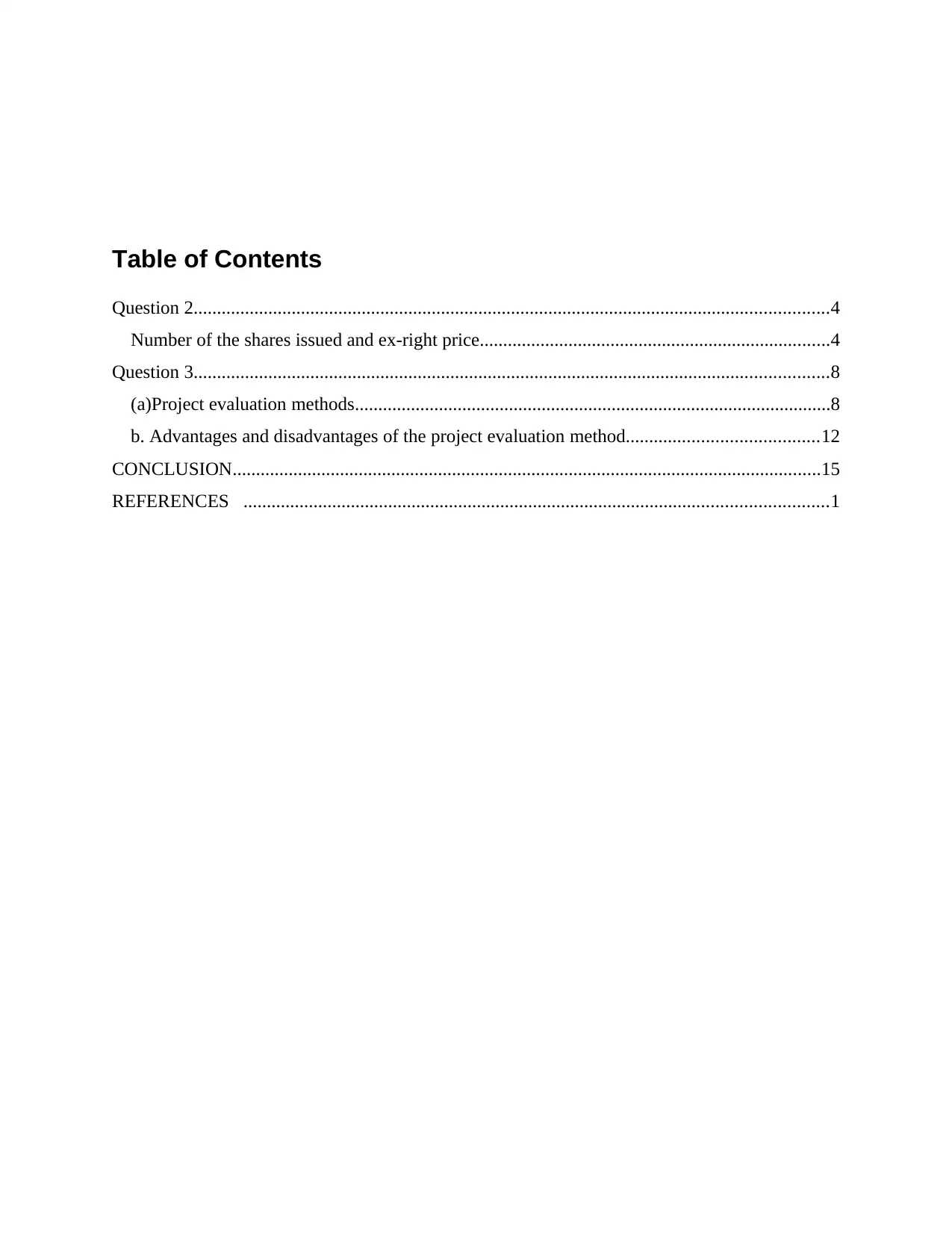
Table of Contents
Question 2........................................................................................................................................4
Number of the shares issued and ex-right price...........................................................................4
Question 3........................................................................................................................................8
(a)Project evaluation methods......................................................................................................8
b. Advantages and disadvantages of the project evaluation method.........................................12
CONCLUSION..............................................................................................................................15
REFERENCES .............................................................................................................................1
Question 2........................................................................................................................................4
Number of the shares issued and ex-right price...........................................................................4
Question 3........................................................................................................................................8
(a)Project evaluation methods......................................................................................................8
b. Advantages and disadvantages of the project evaluation method.........................................12
CONCLUSION..............................................................................................................................15
REFERENCES .............................................................................................................................1
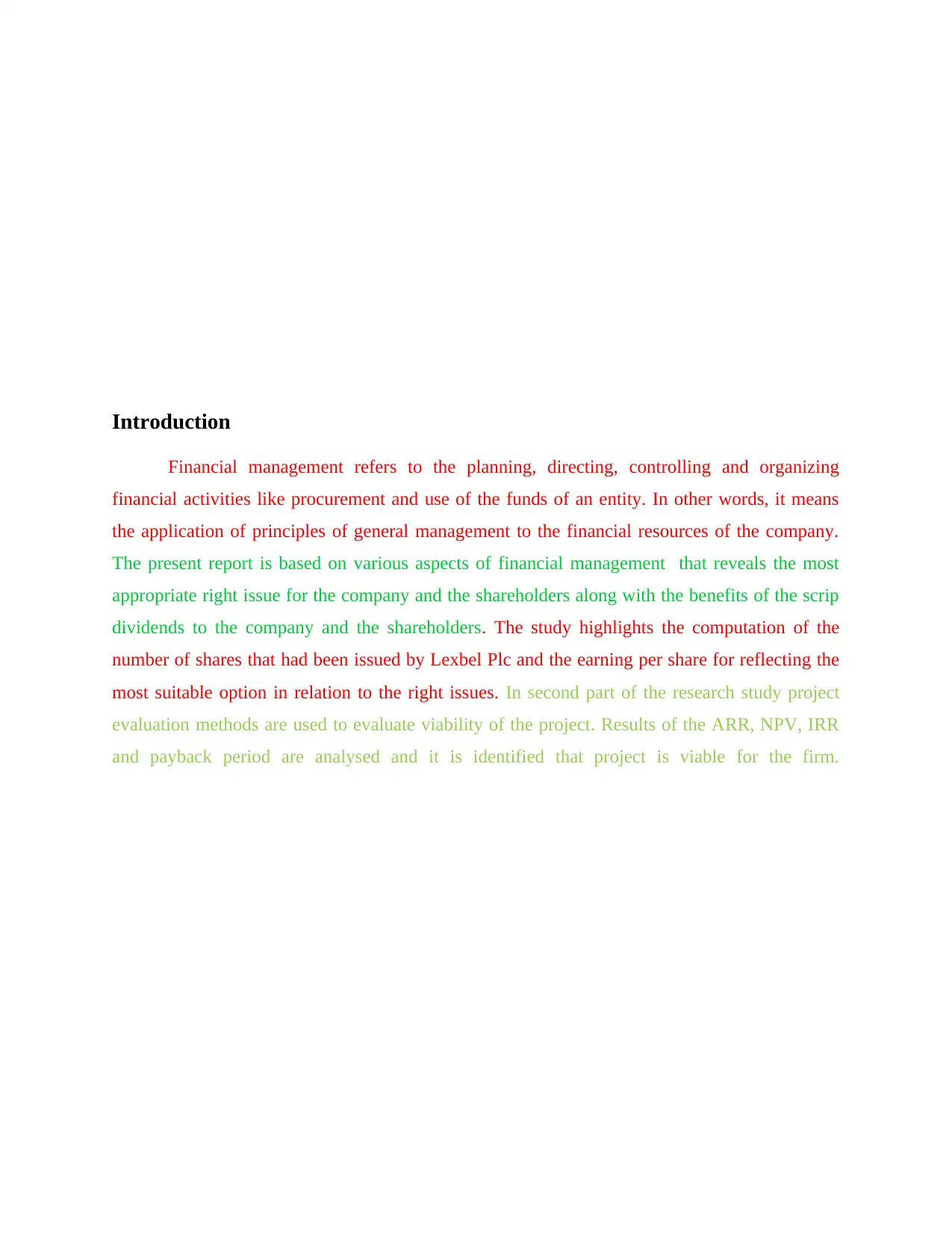
Introduction
Financial management refers to the planning, directing, controlling and organizing
financial activities like procurement and use of the funds of an entity. In other words, it means
the application of principles of general management to the financial resources of the company.
The present report is based on various aspects of financial management that reveals the most
appropriate right issue for the company and the shareholders along with the benefits of the scrip
dividends to the company and the shareholders. The study highlights the computation of the
number of shares that had been issued by Lexbel Plc and the earning per share for reflecting the
most suitable option in relation to the right issues. In second part of the research study project
evaluation methods are used to evaluate viability of the project. Results of the ARR, NPV, IRR
and payback period are analysed and it is identified that project is viable for the firm.
Financial management refers to the planning, directing, controlling and organizing
financial activities like procurement and use of the funds of an entity. In other words, it means
the application of principles of general management to the financial resources of the company.
The present report is based on various aspects of financial management that reveals the most
appropriate right issue for the company and the shareholders along with the benefits of the scrip
dividends to the company and the shareholders. The study highlights the computation of the
number of shares that had been issued by Lexbel Plc and the earning per share for reflecting the
most suitable option in relation to the right issues. In second part of the research study project
evaluation methods are used to evaluate viability of the project. Results of the ARR, NPV, IRR
and payback period are analysed and it is identified that project is viable for the firm.
⊘ This is a preview!⊘
Do you want full access?
Subscribe today to unlock all pages.

Trusted by 1+ million students worldwide
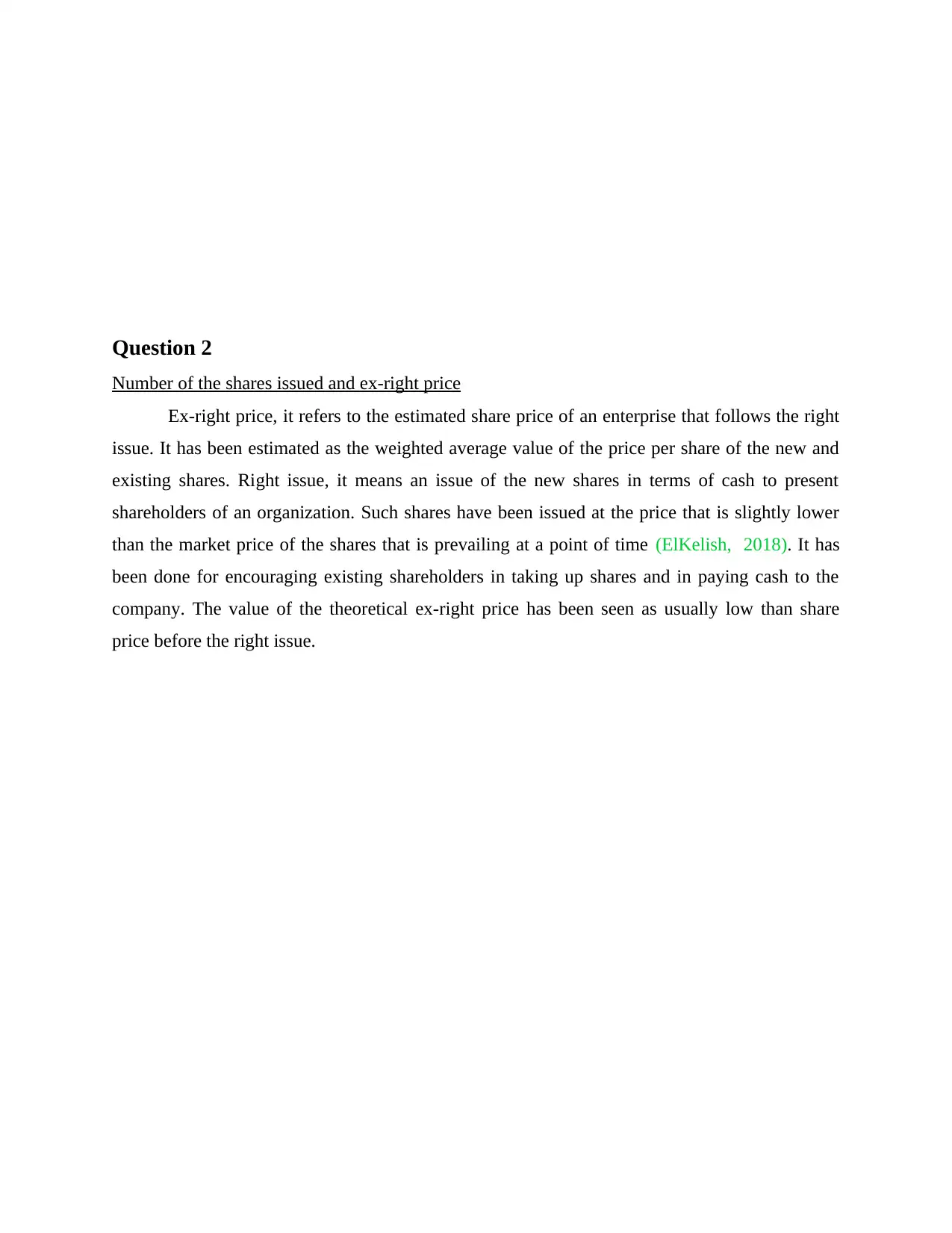
Question 2
Number of the shares issued and ex-right price
Ex-right price, it refers to the estimated share price of an enterprise that follows the right
issue. It has been estimated as the weighted average value of the price per share of the new and
existing shares. Right issue, it means an issue of the new shares in terms of cash to present
shareholders of an organization. Such shares have been issued at the price that is slightly lower
than the market price of the shares that is prevailing at a point of time (ElKelish, 2018). It has
been done for encouraging existing shareholders in taking up shares and in paying cash to the
company. The value of the theoretical ex-right price has been seen as usually low than share
price before the right issue.
Number of the shares issued and ex-right price
Ex-right price, it refers to the estimated share price of an enterprise that follows the right
issue. It has been estimated as the weighted average value of the price per share of the new and
existing shares. Right issue, it means an issue of the new shares in terms of cash to present
shareholders of an organization. Such shares have been issued at the price that is slightly lower
than the market price of the shares that is prevailing at a point of time (ElKelish, 2018). It has
been done for encouraging existing shareholders in taking up shares and in paying cash to the
company. The value of the theoretical ex-right price has been seen as usually low than share
price before the right issue.
Paraphrase This Document
Need a fresh take? Get an instant paraphrase of this document with our AI Paraphraser
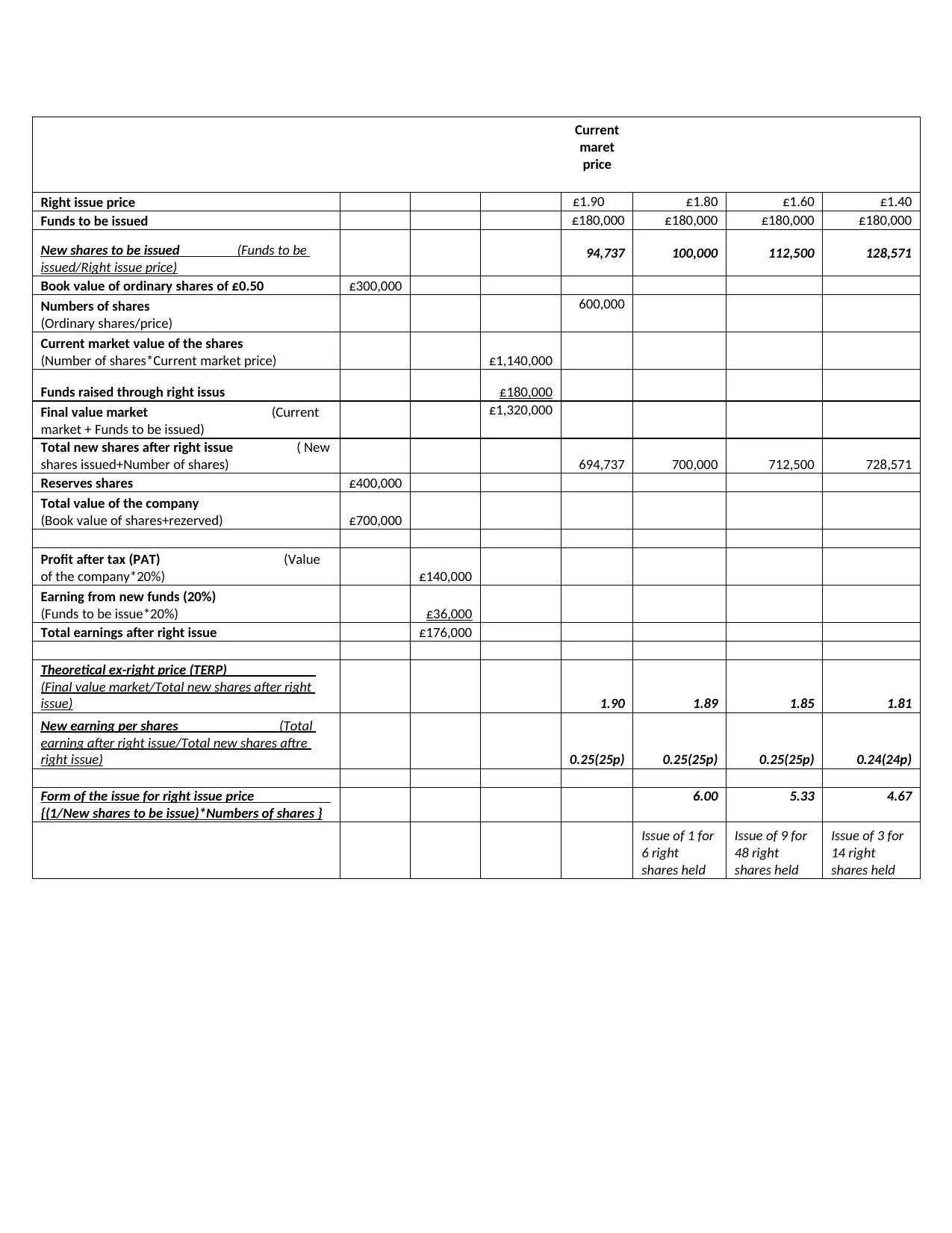
Current
maret
price
Right issue price £1.90 £1.80 £1.60 £1.40
Funds to be issued £180,000 £180,000 £180,000 £180,000
New shares to be issued (Funds to be
issued/Right issue price)
94,737 100,000 112,500 128,571
Book value of ordinary shares of £0.50 £300,000
Numbers of shares
(Ordinary shares/price)
600,000
Current market value of the shares
(Number of shares*Current market price) £1,140,000
Funds raised through right issus £180,000
Final value market (Current
market + Funds to be issued)
£1,320,000
Total new shares after right issue ( New
shares issued+Number of shares) 694,737 700,000 712,500 728,571
Reserves shares £400,000
Total value of the company
(Book value of shares+rezerved) £700,000
Profit after tax (PAT) (Value
of the company*20%) £140,000
Earning from new funds (20%)
(Funds to be issue*20%) £36,000
Total earnings after right issue £176,000
Theoretical ex-right price (TERP)
(Final value market/Total new shares after right
issue) 1.90 1.89 1.85 1.81
New earning per shares (Total
earning after right issue/Total new shares aftre
right issue) 0.25(25p) 0.25(25p) 0.25(25p) 0.24(24p)
Form of the issue for right issue price
{(1/New shares to be issue)*Numbers of shares }
6.00 5.33 4.67
Issue of 1 for
6 right
shares held
Issue of 9 for
48 right
shares held
Issue of 3 for
14 right
shares held
maret
price
Right issue price £1.90 £1.80 £1.60 £1.40
Funds to be issued £180,000 £180,000 £180,000 £180,000
New shares to be issued (Funds to be
issued/Right issue price)
94,737 100,000 112,500 128,571
Book value of ordinary shares of £0.50 £300,000
Numbers of shares
(Ordinary shares/price)
600,000
Current market value of the shares
(Number of shares*Current market price) £1,140,000
Funds raised through right issus £180,000
Final value market (Current
market + Funds to be issued)
£1,320,000
Total new shares after right issue ( New
shares issued+Number of shares) 694,737 700,000 712,500 728,571
Reserves shares £400,000
Total value of the company
(Book value of shares+rezerved) £700,000
Profit after tax (PAT) (Value
of the company*20%) £140,000
Earning from new funds (20%)
(Funds to be issue*20%) £36,000
Total earnings after right issue £176,000
Theoretical ex-right price (TERP)
(Final value market/Total new shares after right
issue) 1.90 1.89 1.85 1.81
New earning per shares (Total
earning after right issue/Total new shares aftre
right issue) 0.25(25p) 0.25(25p) 0.25(25p) 0.24(24p)
Form of the issue for right issue price
{(1/New shares to be issue)*Numbers of shares }
6.00 5.33 4.67
Issue of 1 for
6 right
shares held
Issue of 9 for
48 right
shares held
Issue of 3 for
14 right
shares held
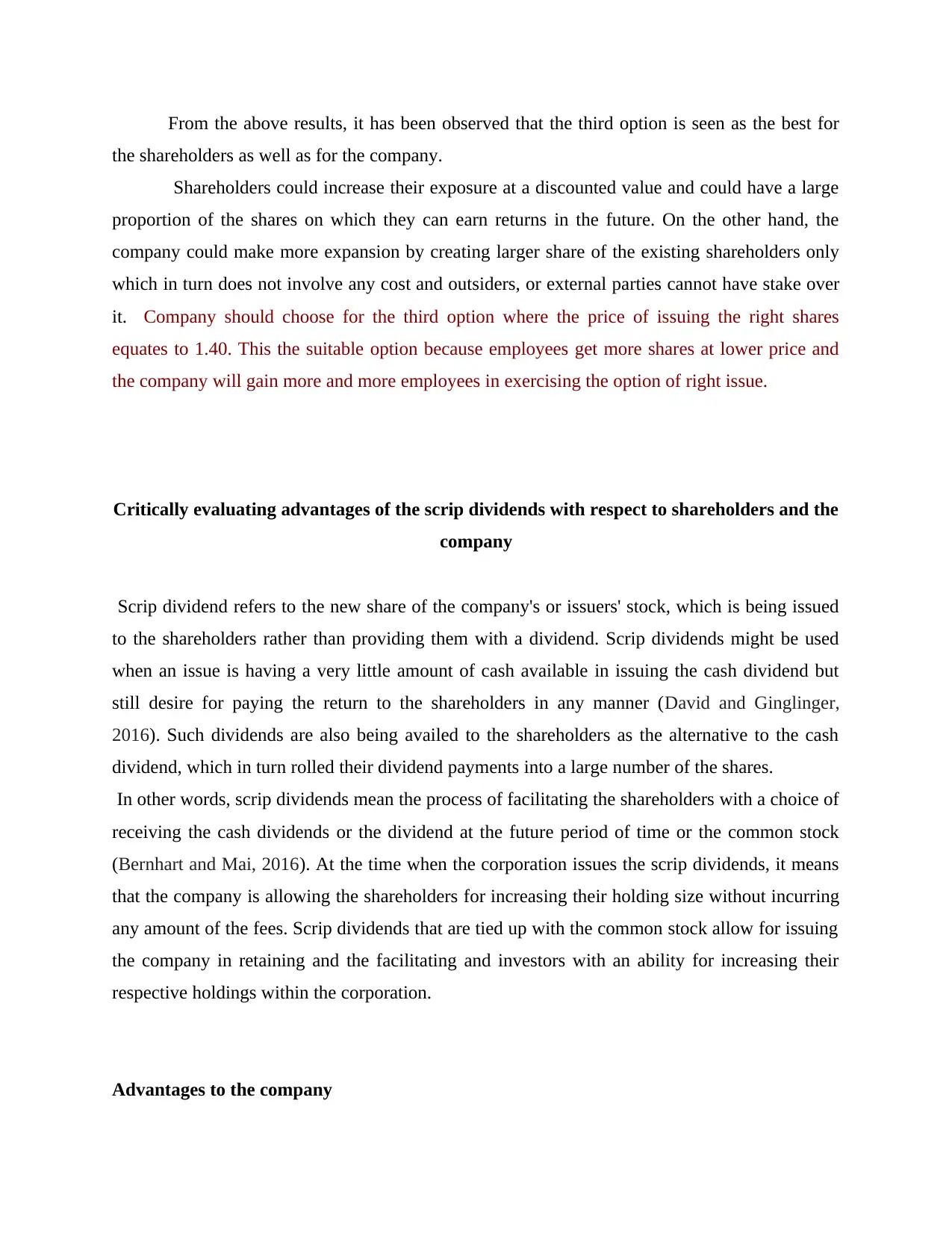
From the above results, it has been observed that the third option is seen as the best for
the shareholders as well as for the company.
Shareholders could increase their exposure at a discounted value and could have a large
proportion of the shares on which they can earn returns in the future. On the other hand, the
company could make more expansion by creating larger share of the existing shareholders only
which in turn does not involve any cost and outsiders, or external parties cannot have stake over
it. Company should choose for the third option where the price of issuing the right shares
equates to 1.40. This the suitable option because employees get more shares at lower price and
the company will gain more and more employees in exercising the option of right issue.
Critically evaluating advantages of the scrip dividends with respect to shareholders and the
company
Scrip dividend refers to the new share of the company's or issuers' stock, which is being issued
to the shareholders rather than providing them with a dividend. Scrip dividends might be used
when an issue is having a very little amount of cash available in issuing the cash dividend but
still desire for paying the return to the shareholders in any manner (David and Ginglinger,
2016). Such dividends are also being availed to the shareholders as the alternative to the cash
dividend, which in turn rolled their dividend payments into a large number of the shares.
In other words, scrip dividends mean the process of facilitating the shareholders with a choice of
receiving the cash dividends or the dividend at the future period of time or the common stock
(Bernhart and Mai, 2016). At the time when the corporation issues the scrip dividends, it means
that the company is allowing the shareholders for increasing their holding size without incurring
any amount of the fees. Scrip dividends that are tied up with the common stock allow for issuing
the company in retaining and the facilitating and investors with an ability for increasing their
respective holdings within the corporation.
Advantages to the company
the shareholders as well as for the company.
Shareholders could increase their exposure at a discounted value and could have a large
proportion of the shares on which they can earn returns in the future. On the other hand, the
company could make more expansion by creating larger share of the existing shareholders only
which in turn does not involve any cost and outsiders, or external parties cannot have stake over
it. Company should choose for the third option where the price of issuing the right shares
equates to 1.40. This the suitable option because employees get more shares at lower price and
the company will gain more and more employees in exercising the option of right issue.
Critically evaluating advantages of the scrip dividends with respect to shareholders and the
company
Scrip dividend refers to the new share of the company's or issuers' stock, which is being issued
to the shareholders rather than providing them with a dividend. Scrip dividends might be used
when an issue is having a very little amount of cash available in issuing the cash dividend but
still desire for paying the return to the shareholders in any manner (David and Ginglinger,
2016). Such dividends are also being availed to the shareholders as the alternative to the cash
dividend, which in turn rolled their dividend payments into a large number of the shares.
In other words, scrip dividends mean the process of facilitating the shareholders with a choice of
receiving the cash dividends or the dividend at the future period of time or the common stock
(Bernhart and Mai, 2016). At the time when the corporation issues the scrip dividends, it means
that the company is allowing the shareholders for increasing their holding size without incurring
any amount of the fees. Scrip dividends that are tied up with the common stock allow for issuing
the company in retaining and the facilitating and investors with an ability for increasing their
respective holdings within the corporation.
Advantages to the company
⊘ This is a preview!⊘
Do you want full access?
Subscribe today to unlock all pages.

Trusted by 1+ million students worldwide
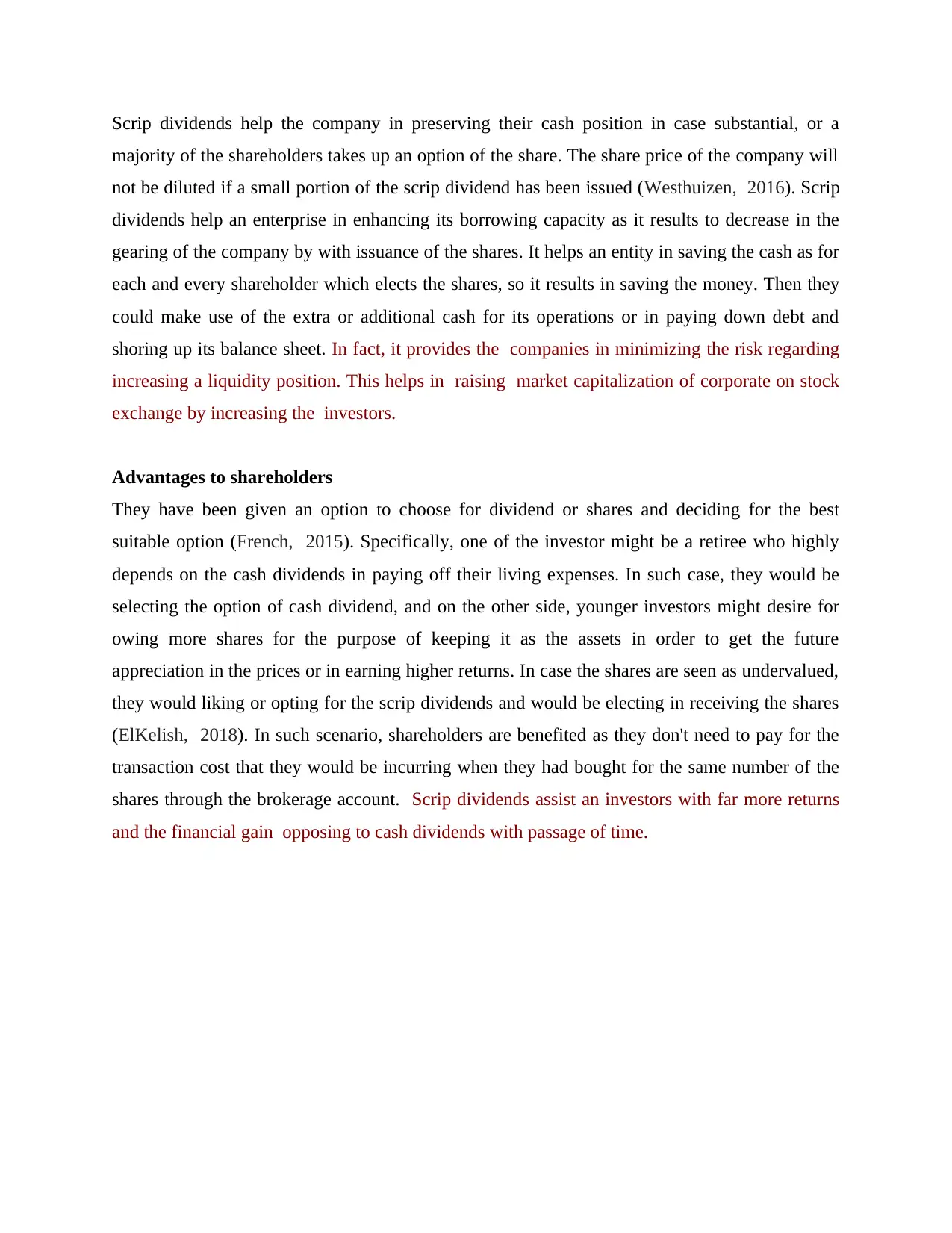
Scrip dividends help the company in preserving their cash position in case substantial, or a
majority of the shareholders takes up an option of the share. The share price of the company will
not be diluted if a small portion of the scrip dividend has been issued (Westhuizen, 2016). Scrip
dividends help an enterprise in enhancing its borrowing capacity as it results to decrease in the
gearing of the company by with issuance of the shares. It helps an entity in saving the cash as for
each and every shareholder which elects the shares, so it results in saving the money. Then they
could make use of the extra or additional cash for its operations or in paying down debt and
shoring up its balance sheet. In fact, it provides the companies in minimizing the risk regarding
increasing a liquidity position. This helps in raising market capitalization of corporate on stock
exchange by increasing the investors.
Advantages to shareholders
They have been given an option to choose for dividend or shares and deciding for the best
suitable option (French, 2015). Specifically, one of the investor might be a retiree who highly
depends on the cash dividends in paying off their living expenses. In such case, they would be
selecting the option of cash dividend, and on the other side, younger investors might desire for
owing more shares for the purpose of keeping it as the assets in order to get the future
appreciation in the prices or in earning higher returns. In case the shares are seen as undervalued,
they would liking or opting for the scrip dividends and would be electing in receiving the shares
(ElKelish, 2018). In such scenario, shareholders are benefited as they don't need to pay for the
transaction cost that they would be incurring when they had bought for the same number of the
shares through the brokerage account. Scrip dividends assist an investors with far more returns
and the financial gain opposing to cash dividends with passage of time.
majority of the shareholders takes up an option of the share. The share price of the company will
not be diluted if a small portion of the scrip dividend has been issued (Westhuizen, 2016). Scrip
dividends help an enterprise in enhancing its borrowing capacity as it results to decrease in the
gearing of the company by with issuance of the shares. It helps an entity in saving the cash as for
each and every shareholder which elects the shares, so it results in saving the money. Then they
could make use of the extra or additional cash for its operations or in paying down debt and
shoring up its balance sheet. In fact, it provides the companies in minimizing the risk regarding
increasing a liquidity position. This helps in raising market capitalization of corporate on stock
exchange by increasing the investors.
Advantages to shareholders
They have been given an option to choose for dividend or shares and deciding for the best
suitable option (French, 2015). Specifically, one of the investor might be a retiree who highly
depends on the cash dividends in paying off their living expenses. In such case, they would be
selecting the option of cash dividend, and on the other side, younger investors might desire for
owing more shares for the purpose of keeping it as the assets in order to get the future
appreciation in the prices or in earning higher returns. In case the shares are seen as undervalued,
they would liking or opting for the scrip dividends and would be electing in receiving the shares
(ElKelish, 2018). In such scenario, shareholders are benefited as they don't need to pay for the
transaction cost that they would be incurring when they had bought for the same number of the
shares through the brokerage account. Scrip dividends assist an investors with far more returns
and the financial gain opposing to cash dividends with passage of time.
Paraphrase This Document
Need a fresh take? Get an instant paraphrase of this document with our AI Paraphraser
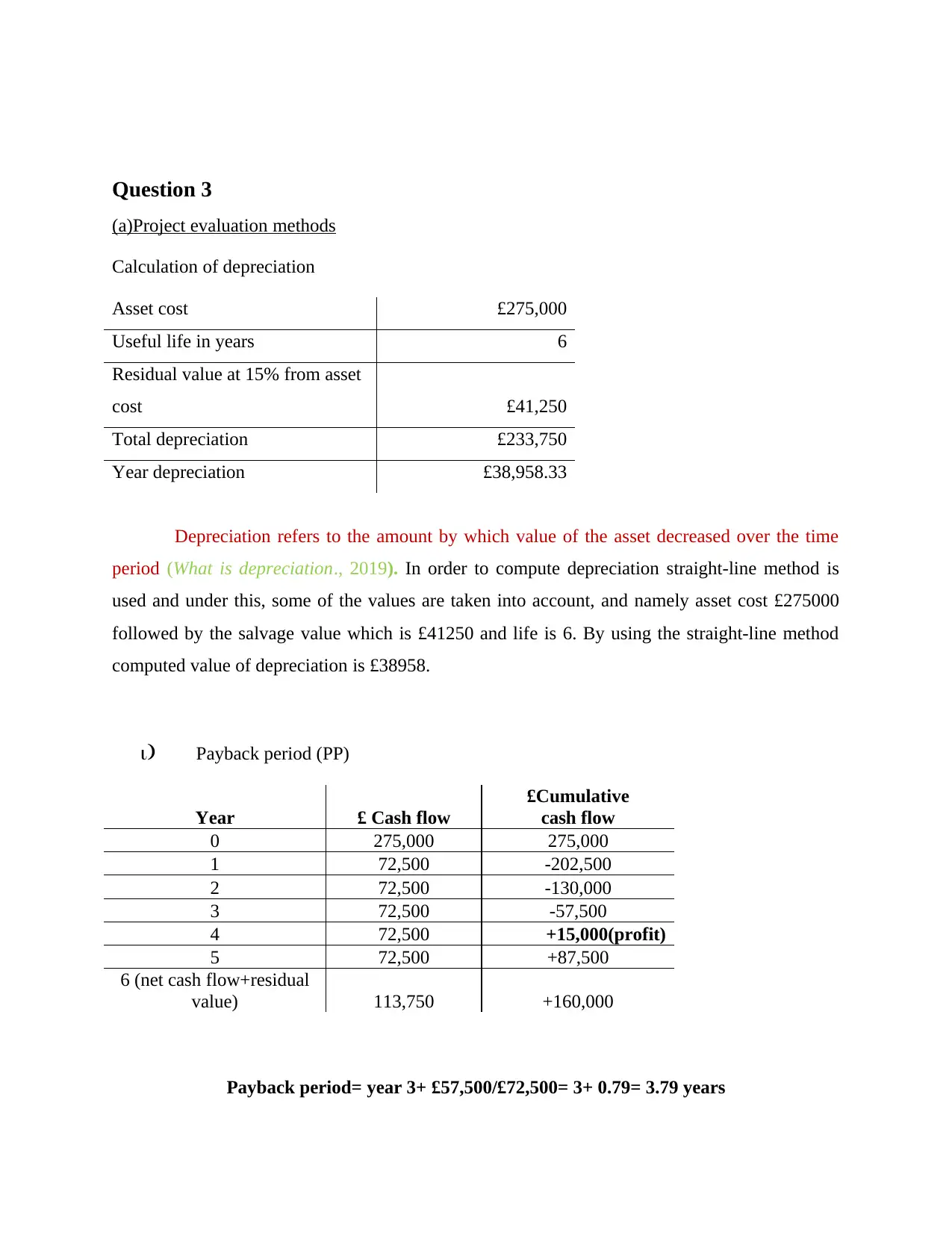
Question 3
(a)Project evaluation methods
Calculation of depreciation
Asset cost £275,000
Useful life in years 6
Residual value at 15% from asset
cost £41,250
Total depreciation £233,750
Year depreciation £38,958.33
Depreciation refers to the amount by which value of the asset decreased over the time
period (What is depreciation., 2019). In order to compute depreciation straight-line method is
used and under this, some of the values are taken into account, and namely asset cost £275000
followed by the salvage value which is £41250 and life is 6. By using the straight-line method
computed value of depreciation is £38958.
i) Payback period (PP)
Year £ Cash flow
£Cumulative
cash flow
0 275,000 275,000
1 72,500 -202,500
2 72,500 -130,000
3 72,500 -57,500
4 72,500 +15,000(profit)
5 72,500 +87,500
6 (net cash flow+residual
value) 113,750 +160,000
Payback period= year 3+ £57,500/£72,500= 3+ 0.79= 3.79 years
(a)Project evaluation methods
Calculation of depreciation
Asset cost £275,000
Useful life in years 6
Residual value at 15% from asset
cost £41,250
Total depreciation £233,750
Year depreciation £38,958.33
Depreciation refers to the amount by which value of the asset decreased over the time
period (What is depreciation., 2019). In order to compute depreciation straight-line method is
used and under this, some of the values are taken into account, and namely asset cost £275000
followed by the salvage value which is £41250 and life is 6. By using the straight-line method
computed value of depreciation is £38958.
i) Payback period (PP)
Year £ Cash flow
£Cumulative
cash flow
0 275,000 275,000
1 72,500 -202,500
2 72,500 -130,000
3 72,500 -57,500
4 72,500 +15,000(profit)
5 72,500 +87,500
6 (net cash flow+residual
value) 113,750 +160,000
Payback period= year 3+ £57,500/£72,500= 3+ 0.79= 3.79 years
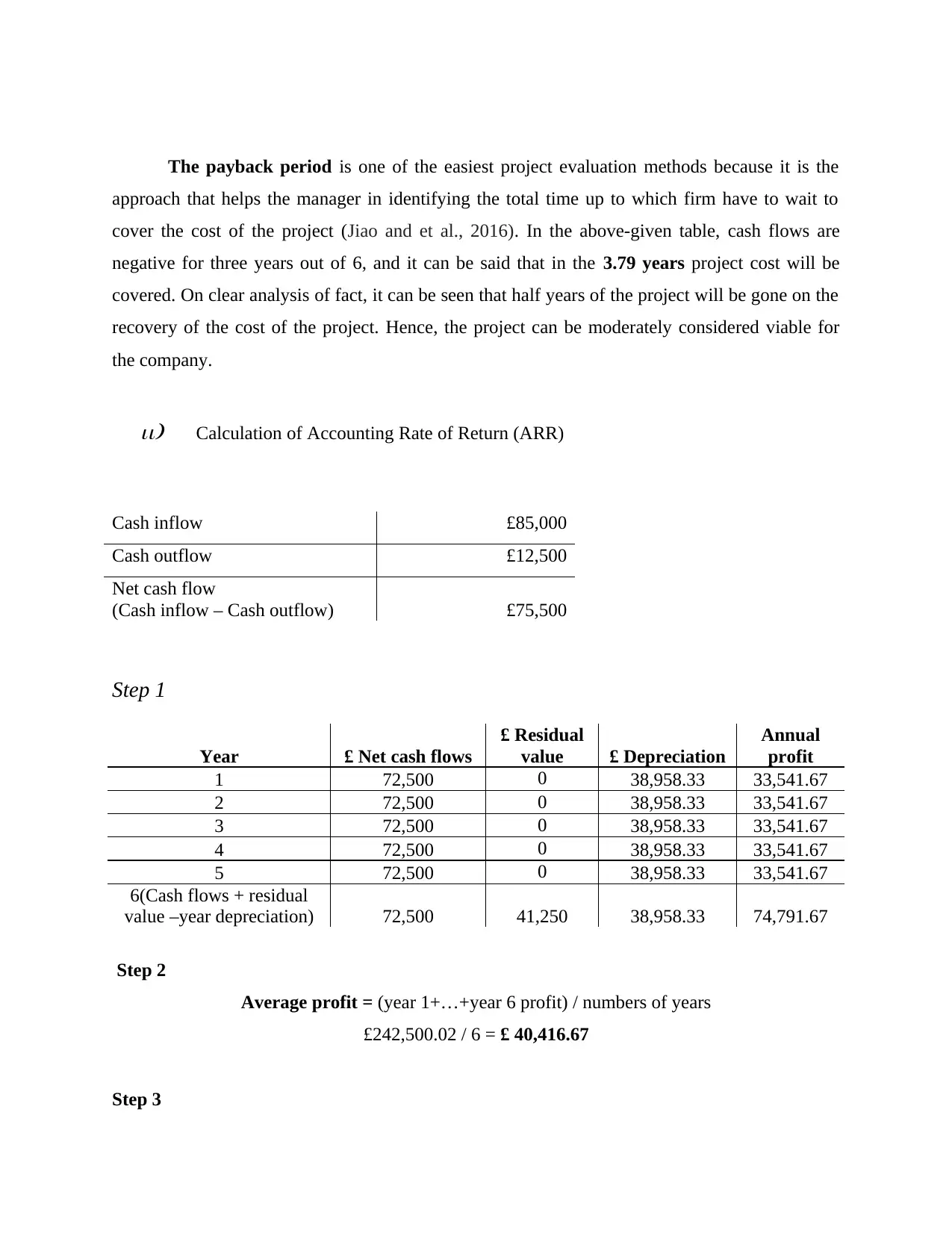
The payback period is one of the easiest project evaluation methods because it is the
approach that helps the manager in identifying the total time up to which firm have to wait to
cover the cost of the project (Jiao and et al., 2016). In the above-given table, cash flows are
negative for three years out of 6, and it can be said that in the 3.79 years project cost will be
covered. On clear analysis of fact, it can be seen that half years of the project will be gone on the
recovery of the cost of the project. Hence, the project can be moderately considered viable for
the company.
ii) Calculation of Accounting Rate of Return (ARR)
Cash inflow £85,000
Cash outflow £12,500
Net cash flow
(Cash inflow – Cash outflow) £75,500
Step 1
Year £ Net cash flows
£ Residual
value £ Depreciation
Annual
profit
1 72,500 0 38,958.33 33,541.67
2 72,500 0 38,958.33 33,541.67
3 72,500 0 38,958.33 33,541.67
4 72,500 0 38,958.33 33,541.67
5 72,500 0 38,958.33 33,541.67
6(Cash flows + residual
value –year depreciation) 72,500 41,250 38,958.33 74,791.67
Step 2
Average profit = (year 1+…+year 6 profit) / numbers of years
£242,500.02 / 6 = £ 40,416.67
Step 3
approach that helps the manager in identifying the total time up to which firm have to wait to
cover the cost of the project (Jiao and et al., 2016). In the above-given table, cash flows are
negative for three years out of 6, and it can be said that in the 3.79 years project cost will be
covered. On clear analysis of fact, it can be seen that half years of the project will be gone on the
recovery of the cost of the project. Hence, the project can be moderately considered viable for
the company.
ii) Calculation of Accounting Rate of Return (ARR)
Cash inflow £85,000
Cash outflow £12,500
Net cash flow
(Cash inflow – Cash outflow) £75,500
Step 1
Year £ Net cash flows
£ Residual
value £ Depreciation
Annual
profit
1 72,500 0 38,958.33 33,541.67
2 72,500 0 38,958.33 33,541.67
3 72,500 0 38,958.33 33,541.67
4 72,500 0 38,958.33 33,541.67
5 72,500 0 38,958.33 33,541.67
6(Cash flows + residual
value –year depreciation) 72,500 41,250 38,958.33 74,791.67
Step 2
Average profit = (year 1+…+year 6 profit) / numbers of years
£242,500.02 / 6 = £ 40,416.67
Step 3
⊘ This is a preview!⊘
Do you want full access?
Subscribe today to unlock all pages.

Trusted by 1+ million students worldwide
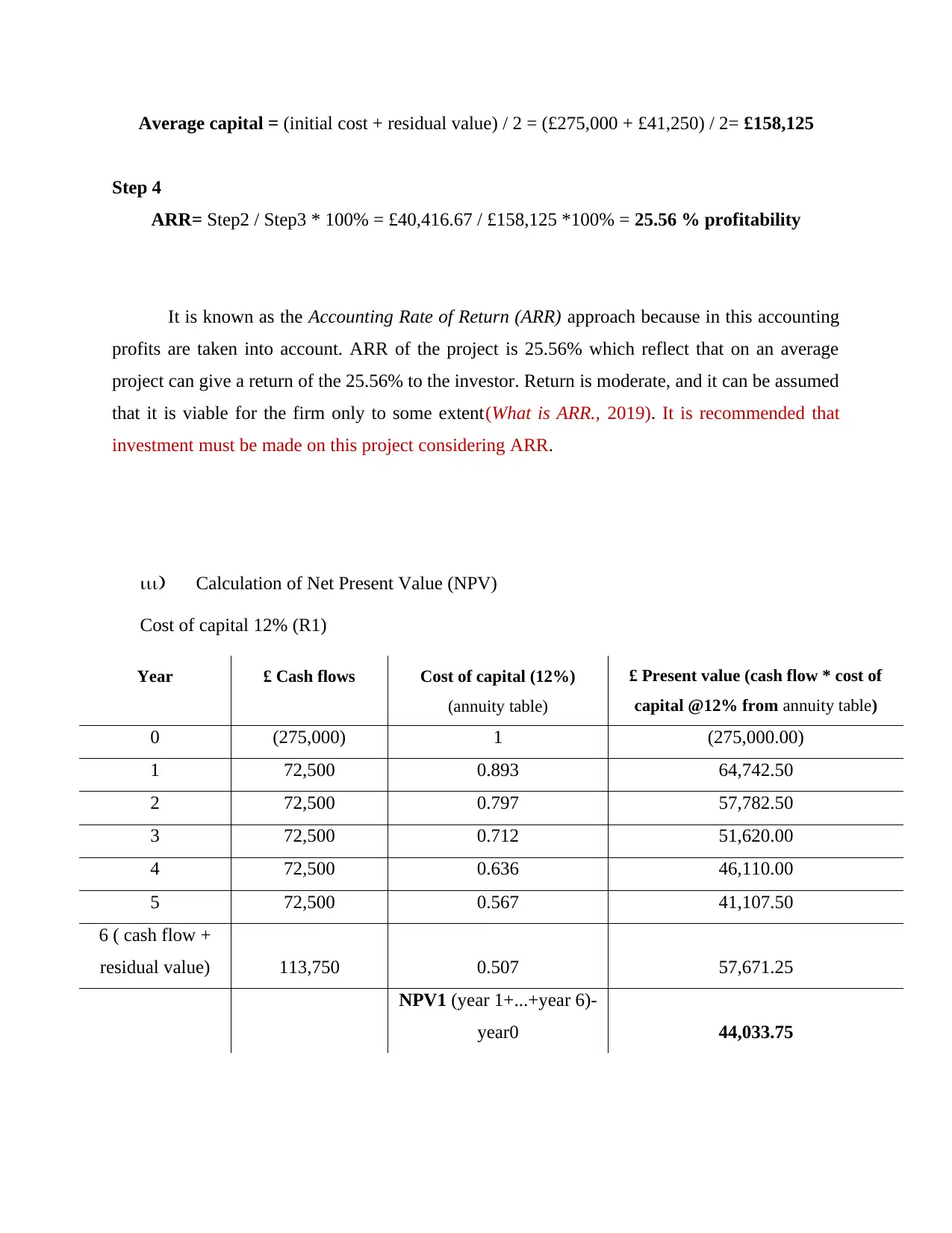
Average capital = (initial cost + residual value) / 2 = (£275,000 + £41,250) / 2= £158,125
Step 4
ARR= Step2 / Step3 * 100% = £40,416.67 / £158,125 *100% = 25.56 % profitability
It is known as the Accounting Rate of Return (ARR) approach because in this accounting
profits are taken into account. ARR of the project is 25.56% which reflect that on an average
project can give a return of the 25.56% to the investor. Return is moderate, and it can be assumed
that it is viable for the firm only to some extent(What is ARR., 2019). It is recommended that
investment must be made on this project considering ARR.
iii) Calculation of Net Present Value (NPV)
Cost of capital 12% (R1)
Year £ Cash flows Cost of capital (12%)
(annuity table)
£ Present value (cash flow * cost of
capital @12% from annuity table)
0 (275,000) 1 (275,000.00)
1 72,500 0.893 64,742.50
2 72,500 0.797 57,782.50
3 72,500 0.712 51,620.00
4 72,500 0.636 46,110.00
5 72,500 0.567 41,107.50
6 ( cash flow +
residual value) 113,750 0.507 57,671.25
NPV1 (year 1+...+year 6)-
year0 44,033.75
Step 4
ARR= Step2 / Step3 * 100% = £40,416.67 / £158,125 *100% = 25.56 % profitability
It is known as the Accounting Rate of Return (ARR) approach because in this accounting
profits are taken into account. ARR of the project is 25.56% which reflect that on an average
project can give a return of the 25.56% to the investor. Return is moderate, and it can be assumed
that it is viable for the firm only to some extent(What is ARR., 2019). It is recommended that
investment must be made on this project considering ARR.
iii) Calculation of Net Present Value (NPV)
Cost of capital 12% (R1)
Year £ Cash flows Cost of capital (12%)
(annuity table)
£ Present value (cash flow * cost of
capital @12% from annuity table)
0 (275,000) 1 (275,000.00)
1 72,500 0.893 64,742.50
2 72,500 0.797 57,782.50
3 72,500 0.712 51,620.00
4 72,500 0.636 46,110.00
5 72,500 0.567 41,107.50
6 ( cash flow +
residual value) 113,750 0.507 57,671.25
NPV1 (year 1+...+year 6)-
year0 44,033.75
Paraphrase This Document
Need a fresh take? Get an instant paraphrase of this document with our AI Paraphraser
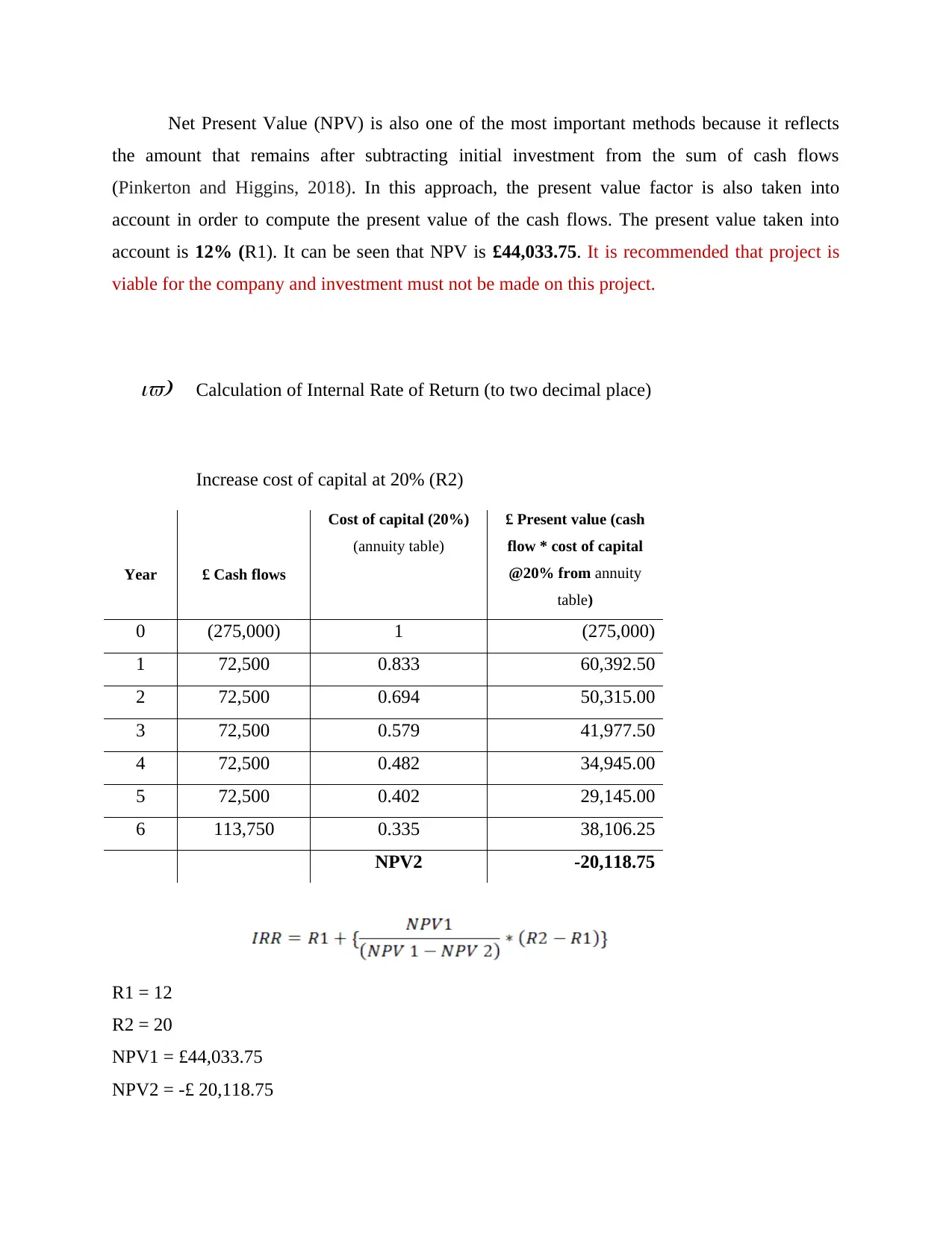
Net Present Value (NPV) is also one of the most important methods because it reflects
the amount that remains after subtracting initial investment from the sum of cash flows
(Pinkerton and Higgins, 2018). In this approach, the present value factor is also taken into
account in order to compute the present value of the cash flows. The present value taken into
account is 12% (R1). It can be seen that NPV is £44,033.75. It is recommended that project is
viable for the company and investment must not be made on this project.
iv) Calculation of Internal Rate of Return (to two decimal place)
Increase cost of capital at 20% (R2)
Year £ Cash flows
Cost of capital (20%)
(annuity table)
£ Present value (cash
flow * cost of capital
@20% from annuity
table)
0 (275,000) 1 (275,000)
1 72,500 0.833 60,392.50
2 72,500 0.694 50,315.00
3 72,500 0.579 41,977.50
4 72,500 0.482 34,945.00
5 72,500 0.402 29,145.00
6 113,750 0.335 38,106.25
NPV2 -20,118.75
R1 = 12
R2 = 20
NPV1 = £44,033.75
NPV2 = -£ 20,118.75
the amount that remains after subtracting initial investment from the sum of cash flows
(Pinkerton and Higgins, 2018). In this approach, the present value factor is also taken into
account in order to compute the present value of the cash flows. The present value taken into
account is 12% (R1). It can be seen that NPV is £44,033.75. It is recommended that project is
viable for the company and investment must not be made on this project.
iv) Calculation of Internal Rate of Return (to two decimal place)
Increase cost of capital at 20% (R2)
Year £ Cash flows
Cost of capital (20%)
(annuity table)
£ Present value (cash
flow * cost of capital
@20% from annuity
table)
0 (275,000) 1 (275,000)
1 72,500 0.833 60,392.50
2 72,500 0.694 50,315.00
3 72,500 0.579 41,977.50
4 72,500 0.482 34,945.00
5 72,500 0.402 29,145.00
6 113,750 0.335 38,106.25
NPV2 -20,118.75
R1 = 12
R2 = 20
NPV1 = £44,033.75
NPV2 = -£ 20,118.75
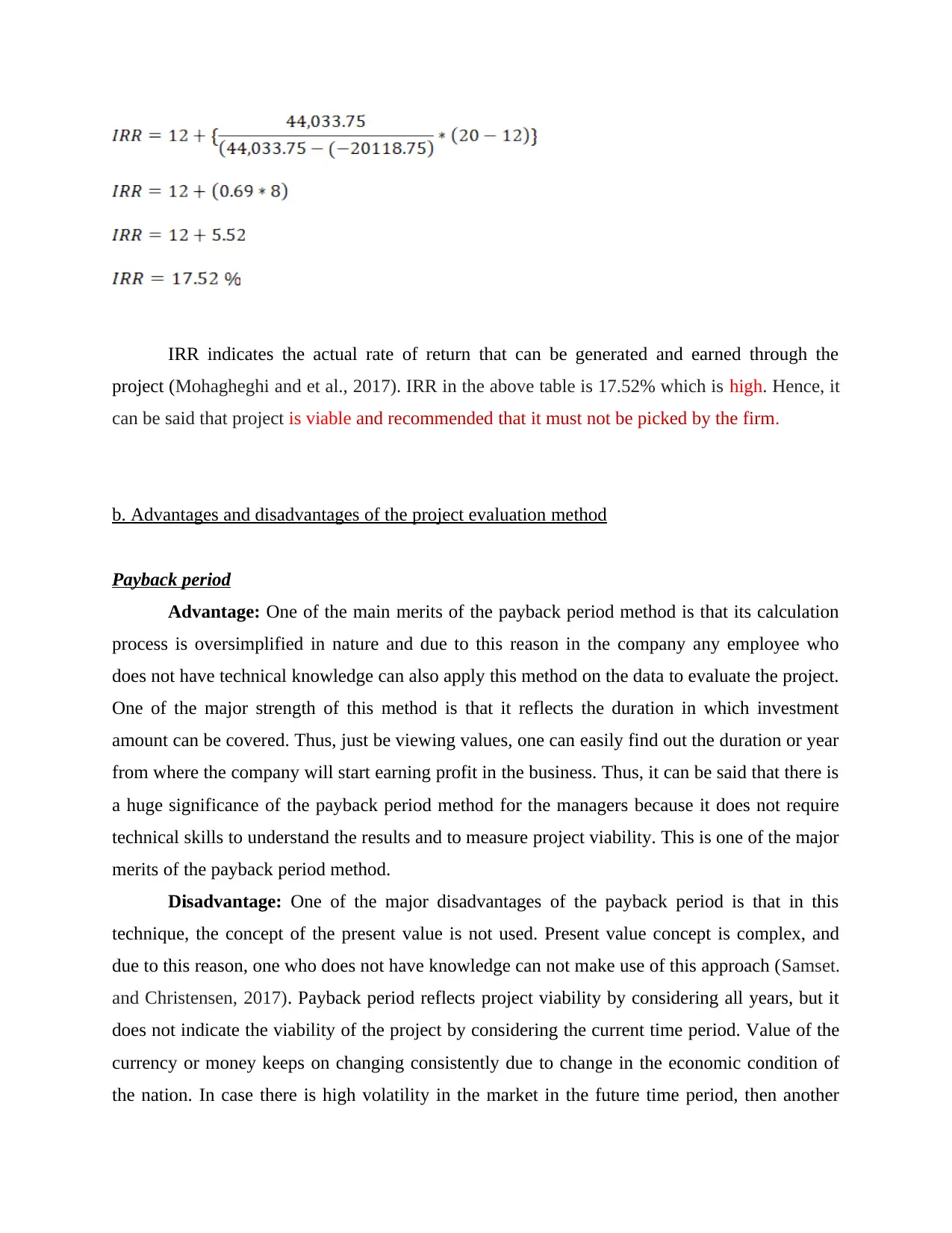
IRR indicates the actual rate of return that can be generated and earned through the
project (Mohagheghi and et al., 2017). IRR in the above table is 17.52% which is high. Hence, it
can be said that project is viable and recommended that it must not be picked by the firm.
b. Advantages and disadvantages of the project evaluation method
Payback period
Advantage: One of the main merits of the payback period method is that its calculation
process is oversimplified in nature and due to this reason in the company any employee who
does not have technical knowledge can also apply this method on the data to evaluate the project.
One of the major strength of this method is that it reflects the duration in which investment
amount can be covered. Thus, just be viewing values, one can easily find out the duration or year
from where the company will start earning profit in the business. Thus, it can be said that there is
a huge significance of the payback period method for the managers because it does not require
technical skills to understand the results and to measure project viability. This is one of the major
merits of the payback period method.
Disadvantage: One of the major disadvantages of the payback period is that in this
technique, the concept of the present value is not used. Present value concept is complex, and
due to this reason, one who does not have knowledge can not make use of this approach (Samset.
and Christensen, 2017). Payback period reflects project viability by considering all years, but it
does not indicate the viability of the project by considering the current time period. Value of the
currency or money keeps on changing consistently due to change in the economic condition of
the nation. In case there is high volatility in the market in the future time period, then another
project (Mohagheghi and et al., 2017). IRR in the above table is 17.52% which is high. Hence, it
can be said that project is viable and recommended that it must not be picked by the firm.
b. Advantages and disadvantages of the project evaluation method
Payback period
Advantage: One of the main merits of the payback period method is that its calculation
process is oversimplified in nature and due to this reason in the company any employee who
does not have technical knowledge can also apply this method on the data to evaluate the project.
One of the major strength of this method is that it reflects the duration in which investment
amount can be covered. Thus, just be viewing values, one can easily find out the duration or year
from where the company will start earning profit in the business. Thus, it can be said that there is
a huge significance of the payback period method for the managers because it does not require
technical skills to understand the results and to measure project viability. This is one of the major
merits of the payback period method.
Disadvantage: One of the major disadvantages of the payback period is that in this
technique, the concept of the present value is not used. Present value concept is complex, and
due to this reason, one who does not have knowledge can not make use of this approach (Samset.
and Christensen, 2017). Payback period reflects project viability by considering all years, but it
does not indicate the viability of the project by considering the current time period. Value of the
currency or money keeps on changing consistently due to change in the economic condition of
the nation. In case there is high volatility in the market in the future time period, then another
⊘ This is a preview!⊘
Do you want full access?
Subscribe today to unlock all pages.

Trusted by 1+ million students worldwide
1 out of 18
Related Documents
Your All-in-One AI-Powered Toolkit for Academic Success.
+13062052269
info@desklib.com
Available 24*7 on WhatsApp / Email
![[object Object]](/_next/static/media/star-bottom.7253800d.svg)
Unlock your academic potential
Copyright © 2020–2025 A2Z Services. All Rights Reserved. Developed and managed by ZUCOL.





